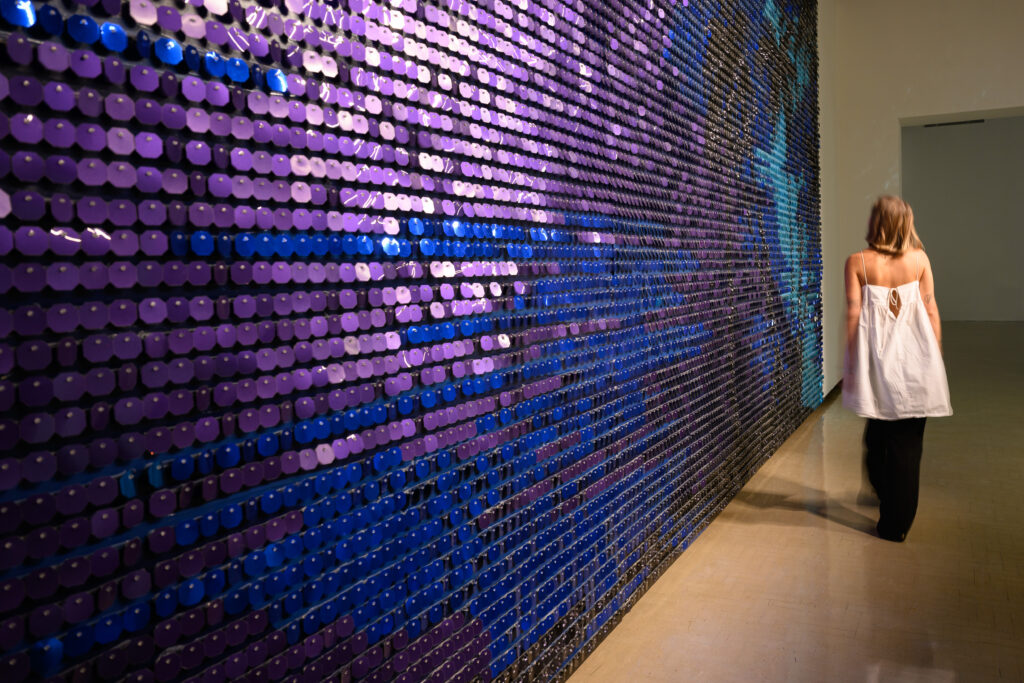By City Gallery Wellington Te Whare Toi Senior Curator Aaron Lister
One of my favourite views of the exhibition Reuben Paterson: The Only Dream Left is from outside City Gallery Wellington Te Whare Toi at night. Looking through the glass doors you see that a four-and-a-half metre glittered tree has mysteriously taken root. The Golden Bearing is backlit by the kaleidoscopic animation Te Maiea. The animation fills the entire space with pulsating waves of light and colour.

It might seem strange for a curator to enjoy such an after-hours moment when the lights are off and the doors are closed. But this twilight time truly brings forth the magic of Paterson’s (Ngāti Rangitihi, Ngāi Tūhoe, Tūhourangi) art. There is a real ‘Night at the Museum’ vibe. This is an exhibition that doesn’t sleep. You can imagine the art works coming to life, rearranging themselves, preparing for tomorrow’s visitors. His art works are there to see us, as much as we do them. We perform for them as much as they perform for us. This is their time.
I especially sense this magic when peering through the gallery doors at night. Others love this view too. The hand and nose prints left on the glass testify to it. I’ve seen many nocturnal visitors drawn towards these glowing doors like the proverbial moth to the flame. It’s often runners, or couples or trios huddling together and craving cultural sustenance on bitter Wellington evenings.
This exhibition will be remembered through the photographs of our day-time visitors. There are some ridiculously cute images of school kids circling the tree hand-in-hand. We feel honoured that so many of the city’s recent graduates marked this occasion with a photograph taken in front of the tree. But those nocturnal experiences are also vital. I know those visitors will return. Hopefully it will be in the daytime, but they will certainly return in their memory and imagination. Because these are the spaces where Paterson’s work leads us all.

Paterson’s art often moves between inside and outside, and night and day. The transgression of ‘normal’ experience and expectation is one of his key tools. The Golden Bearing was originally made for New Plymouth’s Pukekura Park. Te Maiea was first projected onto the exterior of Auckland’s Aotea Centre at night. While currently sitting inside the foyer of City Gallery, both really live elsewhere. They exist in that realm of the imaginary that Paterson’s art opens for us all. The encounters and experiences he stages often push against what you think art might be or do, or where you might find it.
Te Maiea is silent. But it invites visitors to match their music to its visuals. This has spawned a user-generated playlist that currently clocks in at just over six and a half hours. You would have to watch the animation eighty-six times to hear all of these songs. Consider that invitation taken up.
This exhibition celebrates Paterson’s immense contribution to art in Aotearoa. It is also a farewell. He has just moved to New York. He is determined to try his hand in this most glittery and cut-throat of art world cities. Making it there is one of the dreams invoked in the exhibition’s title.
The Only Dream Left closes in mid-June. After that, we might all have to view Paterson’s art for a while from distance and through the glass doors of our digital screens. But the possibilities in terms of where he and these doors will transport us next are limitless.

IMAGE 1 Reuben Paterson: The Only Dream Left, City Gallery Wellington Te Whare Toi, 2023. Photo: Cheska Brown.
IMAGE 2 Reuben Paterson, When the Sun Rises and the Shadows Flee, 2005, Collection of the Dunedin Public Art Gallery
IMAGE 3 Reuben Paterson: The Only Dream Left, City Gallery Wellington Te Whare Toi, 2023. Photo: Cheska Brown.
